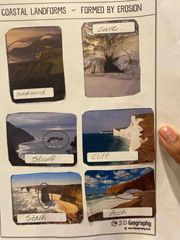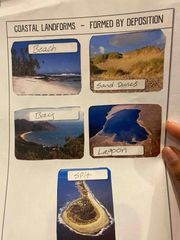![]()
![]()
![]()
Use LEFT and RIGHT arrow keys to navigate between flashcards;
Use UP and DOWN arrow keys to flip the card;
H to show hint;
A reads text to speech;
30 Cards in this Set
- Front
- Back
|
Coastal Zone |
The interface where the land meets the ocean |
|
|
Marine Subsystem |
Questions Below |
|
|
Characteristics |
-Diversity of marine habitats -Water depth -salinity |
|
|
Resources and Uses |
- Exploitation of fisheries - Oil and gas -Recreational Use
|
|
|
Challenges |
-Disturbance and destruction of habitat Overfishing -Pollution |
|
|
Coast Subsystem |
Questions Below |
|
|
Characteristics |
- Coastal Profile (sandy beach, pebble beach,rocky shore( - Tidal Regime, Wind Regime, Shore line topography |
|
|
Resources and Uses |
- Sand and gravel extraction - Exploitation for tourism and recreation
|
|
|
Challenges |
-Disturbances and destruction of costal habitat -Deterioration of costal water quality |
|
|
Terrestrial Subsystem |
Questions Below |
|
|
Characteristics |
-Topography - Soil types
|
|
|
Resources and Uses |
-Agriculture and aquaculture -Human Settlement |
|
|
Challenges |
-destruction of terrestrial habitats -reduction of freshwater availability and quality |
|
|
Coastline |
The general area where the land meets the ocean |
|
|
Shoreline |
The precise measurement where the land meets the ocean |
|
|
Weathering |
Questions Below |
|
|
What is it? |
The breaking down of rocks and sediment over time |
|
|
Erosion |
The movement of weathered down rocks or sediment |
|
|
Long shore drift and how it effects the beach |
The main way that sediment is moved and deposited along a coastline. |
|
|
Long shore drift (Definition,Diagram) |
When waves that hit the beach at an angle and carry sediment up the beach at an angle (swash). When the water washes back the sediment is carried back down the beach (backwash). Individual particles are moved along the beach in a zig zag pattern |
|
|
Deposition |
the laying down of sediment that has been carried by erosion |
|
|
3 types of weathering (definition,example) |
Mechanical-Involves breaking of larger rocks into smaller rocks (water seeping into a rock, water freezes, expands and causes the rock to crack making it easy to break into smaller pieces) Chemical-Involves changes in the minerals of the rock or on the surface of the rock that make the rock change color or shape (some rocks contain minerals like iron, so when that iron is exposed to oxygen it causes the rock to soften,making it easier to break apart into smaller pieces). Biological- involves larger rocks breaking into smaller pieces which is caused by plants animals or other living organisms. (A plants roots find their way into the opening of a rock, eventually as that plant grows the rock will start to crack open until it breaks apart into smaller pieces). |
|
|
Erosional Features |

|
|
|
Depositional Features |

|
|
|
Types of Coastal Zones (Tide Pools) |
Physical characteristics: -They have shallow depths and assist in the flow of tides. -Tide pools are very rocky formations. -They form in the intertidal zone long rocky coastlines where the ocean meets the land. Biological characteristics: Tidal pools provide a home for many organisms such as sea stars, mussels and clams Inhabitants deal with a frequently changing environment. Such as: fluctuations in water temperature, salinity, and oxygen content. |
|
|
Case Study Maldives |
Questions Below |
|
|
What problems are the Maldives dealing with? |
Rapid sea level rise Severe erosion Coral Bleaching |
|
|
how do these problems affect the country?(consequences) |
-By 2050, 80% of the Maldives will be uninhabitable -Flooding -Climate Refugees -Loss of land due to severe erosion -Loss of sea protection against storms -Loss of tourism -Loss of a food source (fish) |
|
|
How are they trying to solve these problems |
Making Man made Islands (short term) Building Floating cites |
|
|
Location of the Maldives |
it is an island state in the Indian ocean. |

